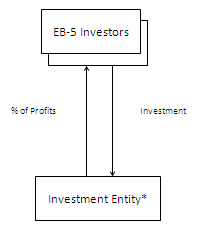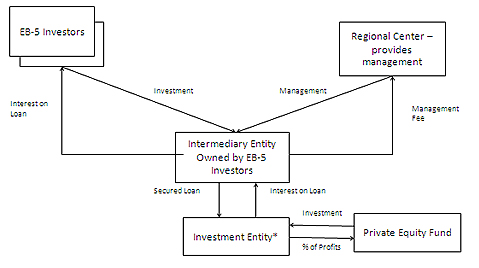EB-5 Insights: How Government Policy can Provide Private Equity Managers with an Alternative Method to Raise Capital
By Pamela Donado, CPA and David Appel, CPA, Partner, PFS

There have always been two traditional ways of raising capital for a new business venture, through traditional institutional financing and from private investors. However, a third less well known form of raising capital through foreign investors, known as “EB-5” or “Immigrant Investor Program” is available. When paired with the traditional forms of raising capital, using foreign EB-5 investors may reduce the cost of capital or financing.
What is EB-5 Capital?
EB-5 is a government sponsored program that was introduced with the Immigration Act of 1990. The program permits foreign nationals and their immediate family to earn their permanent alien visa (green card) by investing either $500,000, if in a Targeted Employment Area (TEA), or $1,000,000 in a qualifying business enterprise that will create at least 10 new U.S. jobs per foreign capital investment. The initial application requires the foreign national (applicant) to file an I-526 application with the United States Citizenship and Immigration Services (USCIS) which includes information about the investment, a source of funds report which proves that the funds used for the investment were derived from legal means, and the application to change non-immigrant status. After the initial application and acceptance, the foreign nationals receive a conditional green card.After approximately 24 months, USCIS requires an additional application to demonstrate that the investment has created and sustained the U.S jobs required by the program. If approved, the foreign national receives their permanent alien card.
Why use it?
The advantage of investing with foreign investors through the EB-5 program is the low cost of capital. Since most foreign investors are highly motivated to obtain their green cards, they don’t demand a high return on their investment. EB-5 capital, coupled with the traditional ways of raising capital, can be an ideal method to fund a private equity venture where financing is limited or lower financing costs can be obtained.
What are the requirements?
There are two ways to raise capital through the EB-5 program; through a regional center investment or a direct investment.
When a private equity fund or private investors are raising capital through a regional center they or the regional center will need to apply for the designation by filing the I-924 application with USCIS and pay the filing fee. A regional center is an investment promotion entity approved by USCIS that is involved with the promotion of economic growth, improved regional productivity, job creation and increased domestic capital investment. The application process for the I-924 involves hiring an economist to prepare the job calculation, job creation reports, and to evaluate whether the regional center will be located in a targeted employment area. A TEA is a geographic area that must not be within a metropolitan statistical area as labeled by the US office of Management and Budget or an area that experiences an unemployment rate of at least 150% of the US National average and must be in a county where the population is of 20,000 or more residents. If the regional center is in a TEA it lowers the amount of the required investment per foreign national from $1,000,000 to $500,000. The application also requires developing a business plan and engaging an escrow agent and a securities attorney to ensure that the investments are properly structured and are in compliance with SEC regulations. Once the application is approved investors can begin making their capital investments and filing their I-526 applications. The capital investment made by the foreign investors is only available when the I-526 petition is approved by USCIS.
It should be noted that under the regional center method you can either create a regional center or submit a project under a pre-existing regional center. Using an existing regional center is often beneficial due to the fact that it usually lowers costs because you don’t have to go through the process of creating one yourself. However you should seek legal advice and perform due diligence on the regional center you would use to make sure it is the right decision.
The second way of raising capital through the EB-5 program is through a direct investment. The direct investment requires a foreign investor to establish and directly invest in a business. While the USCIS still requires 10 U.S. jobs created by the new business, there is a further requirement that the jobs must be directly related to the new business. This method is less attractive since the foreign investor is required to be materially involved in day to day operations of the business.
Out of the two methods available most investors prefer the regional center method since it’s faster, less expensive and USCIS requirements are less rigorous for the EB-5 visa applicant. The job requirement under the regional center can also include indirect jobs in addition to the 10 direct jobs requirements. Indirect job can include construction jobs. Based on prior applications, Congress has been giving USCIS discretion to give priority to EB-5 applications filed through regional centers.
Attracting Foreign Investors
Making your business proposal attractive to foreign investors is important. Although the main focus of foreign investors is receiving their green card they still demand a return on their investment and are sensitive to having their funds tied up in a long term investment with low returns.There are various ways to structure the investment to make it attractive to investors. They can either invest directly or provide a loan to the qualified investment.
Using the direct investment structure the capital raised from EB-5 investors is invested directly into an investment entity where they become equity partners and are entitled to a percentage of the profits and losses. This structure is usually used when you are using capital to fund a business since the EB-5 investors feel more confident investing directly and controlling a business.

*the activities of investment entity often include franchise operations
Another corporate structure and having particular interest to private equity funds is the loan method (i.e. regional center). Under this structure the capital raised through the EB-5 investors is invested into an intermediary entity (usually an LLC/LP) which then loans the funds to the investment entity that invests in the business that qualifies for the program. This can be achieved by making the collateralized loan through an intermediary entity and future payback of the loan through a sale or refinance of the investments assets.

*The activities of the investment entity often includes hotel development projects, mixed use commercial projects, time sharing projects, and operating business such as restaurants
Regardless of the method of investment used, the investment entity manager needs to take into consideration the tax filing requirements of the newly formed entities. In addition to regular partnership tax filing requirements you need to keep in mind some additional filing requirements that may be triggered due to the foreign partner’s non-resident status for tax purposes when they initially become partners. Once the foreign investors receive their green cards the extra tax filing requirements are eliminated.
Evaluating whether this is the best option
Although raising capital through the EB-5 program can seem easy and less costly, there are other factors that need to be taken into consideration when using this method to fund a new business. Some factors that need to be considered are making sure your professionals are knowledgeable in the EB-5 area, the expense of filing fees, and the waiting time between the different steps.
There are many people involved that play a significant role in the process of creating an EB-5 investment and while most of the professional services needed are the same as in a normal business setting, there are some specific services that are very important to the process. An economist is required to create the econometric/job impact report that defines the amount of capital that can be brought into a project based on the amount of jobs that are directly created by the new business. The report satisfies the Government’s major requirement of job creation. You will also need a business plan writer; this is the person in charge of creating the corporate structure of your business plan. A business writer is another essential person because in addition to making it compliant to the EB-5 requirements, it will also need to be attractive to foreign investors. A securities attorney and corporate attorney are also required because the business needs to be compliant with both securities and business laws.
While it’s true that this method of raising capital is less costly there are some overhead costs to take into consideration. The different applications that need to be filed with USCIS have substantial fees. You will also need to consider the costs of the professional services that are required to get the project up and running as well as the marketing efforts that are needed to find foreign investors. If you are using mixed capital to fund a business, such as financing or equity, you will need to consider the cost of raising that type of capital in addition to the costs mentioned above.
Lastly, you need to take into consideration the time it takes to be able to raise the capital. The EB-5 process doesn’t have a specific amount of time in which it should be completed. Different steps have different time frames in which they should be completed but vary from case to case. The entire process can take anywhere from over a year to up to two years depending on the work load of USCIS and the complexity of the business proposal. The investment funds are held in escrow until the applicant is approved by USCIS. Private equity managers need to be mindful of the time constraints of the EB-5 process.
To use or not use
Although the EB-5 program has led to many successful businesses, it is important that both the foreign investors and private equity managers looking for financing are aware of the complexities of the process. When blended with the traditional means of raising capital, using the EB-5 program may result in a lower total cost of capital or an alternate method to raise capital for a business venture.
Marcum can provide guidance on evaluating whether the program is a good option for you and guide you through the process if you were to decide to use the EB-5 program to raise capital for your business.


















